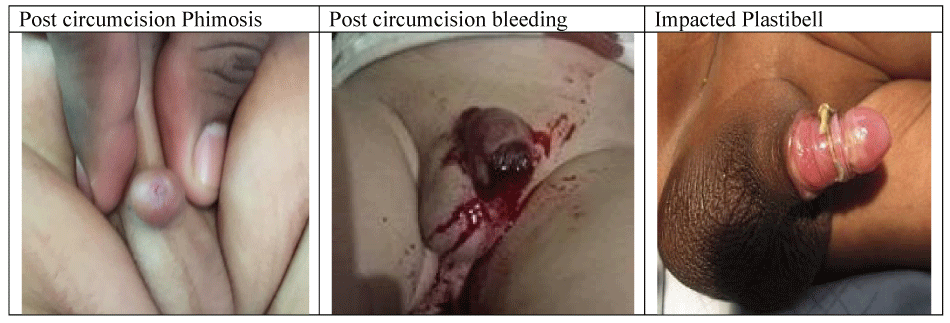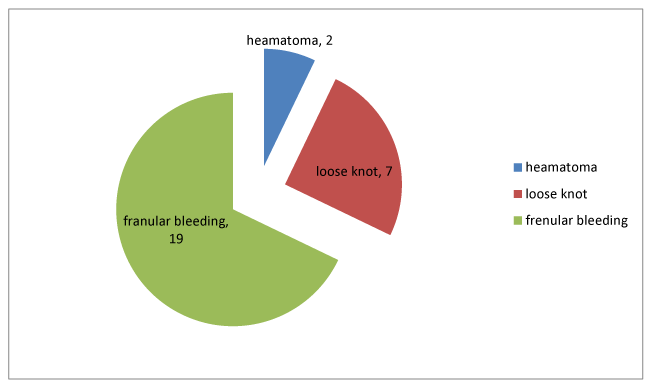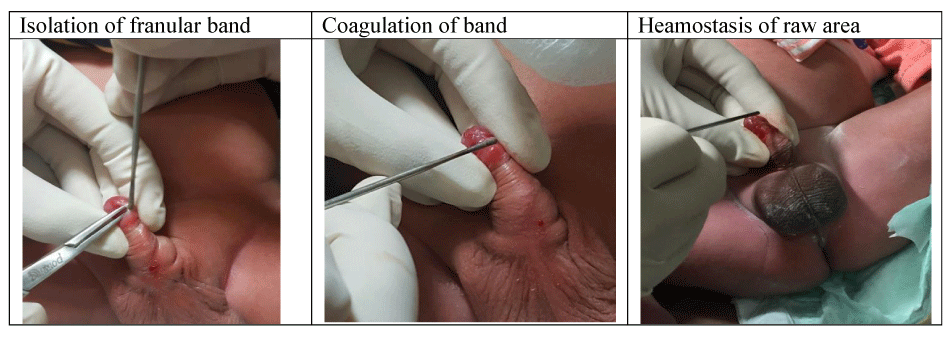Journal of Surgery and Surgical Research
Incidence of Complications in Plastibell Circumcision in Male Infants: Comparison between with and without Coagulation Hemostasis methods
Naima Rasool*
Cite this as
Rasool N (2017) Incidence of Complications in Plastibell Circumcision in Male Infants: Comparison between with and without Coagulation Hemostasis methods. J Surg Surgical Res 3(2): 034-037. DOI: 10.17352/2455-2968.000042Introduction: Circumcision remains the commonest performed surgical procedure in outpatients. Circumcision with Plastibell is the most popular used method of circumcision among surgeons. As any other surgical procedure, it inherits complications, bleeding being the commonest. The aim of this study is to compare the incidence of post-operative complications in circumcision performed with Plastibell with and without coagulation hemostasis in male infants in the outpatient department of Pediatric Surgery, Combined Military Hospital, Lahore.
Methods: This study assesses the data of all infants circumcised in outpatient department with Plastibell. All infants were divided in two groups. In Group A, total 170 circumcisions were performed without frenular hemostasis. In Group B, total 193 circumcisions were performed with frenular hemostasis, over the total period of 2 years.
Results: Among 170 patients in group A, 30 patients had complication, out of which 28 had bleeding. In group B, after coagulation hemostasis of frenular band, 193 circumcisions were done. Only 2 patients out of 193 had complications. None of them had post circumcision bleeding. Frenular band was found and coagulated in 98 (50.77%) patients.
Conclusion: Circumcision with Plastibell in infants is a safe procedure; post circumcision bleeding can be avoided by careful application of Plastibell and dealing with frenular band with coagulation hemostasis.
Introduction
In Pakistan, neonatal circumcisions are performed commonly out of ritual and religious obligations. Minimal local data is available about the number of procedures performed by non-medical persons, general practioners, gynecologists, Pediatricians, general surgeons, Plastic surgeons, Urologists and Pediatric surgeons. A wide variety of methods are used by different practioners including bone cutter, different kinds of clamps, open method and Plastibell [1]. Complication rate depends upon the method used, age and general condition of the baby, co morbid, anatomical abnormalities, training of the practioner and settings in which circumcision has been carried out. Circumcision with Plastibell is the most popular method among surgeons. It is safe and has minimal complications with excellent outcome in infants. However, it is associated with significant complications in children of more than 1 year of age [2]. It is seldom used in children older than 2 years because of thickening of prepucial skin. Age of circumcision also varies depending upon preference of the family, rituals and condition of the baby. Many complications are reported in literature, commonest being bleeding [3]. Prepuce, glans and frenulum are highly vascularized areas, so even little blood loss is a risk and can become fatal if not addressed promptly [4]. Post circumcision bleeding rate can be reduced to minimum with subtle and careful technique of hemostasis of frenular band and its area.
There is variable incidence of post circumcision bleeding reported in different studies, ranging between 4- 35 % [5,6]. In our practice, our incidence was thought to be a bit higher, so it was decided to do hemostasis of frenular area to curb any post-operative bleeding. A comparative study was planned to document the incidence of post circumcision complications particularly bleeding before and after using the technique of coagulation homeostasis of the frenular area.
Materials and Methods
Patients with any significant history of coagulopathy in the family, cardiac problem, hypospadias, epispadias or other genital anomalies were not included.
All circumcisions were done on babies between 2 days to 2 years of age, under penile ring block local anesthesia followed by adequate oral analgesic drops. After adhenolysis between prepuce and glance with artery forceps, a vertical incision was given in the dorsal prepucial skin for insertion of appropriate sized Plastibel. After ligation of thread in the groove of Plastibell, excess of proximal skin was trimmed. Handle of bell was broken to complete the procedure. Ring falls off in 4-8 days leaving a circumferential wound around glans.
Over the span of 1 year, from 1st October 2014 to 30th September 2015, a total number of 170 circumcisions were performed with Plastibell under local anesthesia in outpatient department. The retrospective data of these 170 infant was reviewed for post circumcision complications. History, examination, type of complication, day of presentation, management provided and outcome were recorded.
An audit was undertaken to look for the causes of bleeding and to establish and implement vigilant measures to minimize this complication. It was decided to avoid the Plastibell with silk thread. During circumcision, frenulum was inspected for any band or bleeding. If band was found, coagulation of band was done with help of warm probe. A spirit lamp with a probe was used to coagulate the obstructing frenular band if present, because of non-availability of bipolar diathermy in outpatient. Pressure of gauze in diaper and revisit of wound after 15-20 minutes was made a routine. Thorough counseling of parents was stressed, particularly about minor swelling, redness and slight serous or blood stains after procedure or at the time of separation of Plastibell.
In next year from 1st October 2015 to 30th September 2016, a total of 193 infants underwent Plastibell circumcision along with hemostasis of frenular band and its area. Patients were followed at 01 week and 01 month period and they were advised to visit if any complication arises.
After approval from hospital ethical committee, a comparative study was undertaken to document the incidence of post circumcision bleeding, its causes, treatment provided and other complications before and after incorporation of coagulation hemostasis in Plastibell circumcision.
Results
In Group A, among 170 babies, 123 were neonates, 42 were infants and 05 were between 1-2 years of age. Post-operative complications recorded were, proximal migration of ring in 1/170 (0.58%), Phimosis in 1/170 (0.58%) while 28/170 (16.47%) patients had significant post circumcision bleeding within 48 hours of procedure, which required hospital visit, removal of the bell and cauterization of bleeder and/or suturing of raw area in operation theater. Antibiotic cover was given to all of them after suturing. None of them required blood transfusion or hospital admission.
In group B, after incorporation of coagulation hemostasis of the area, a total number of 193 circumcisions were performed during the period of 1st October 2015 to 30th September 2016. Out of 193 patients, 151 were neonates, 38 were infants and 04 were between 1-2 years of age. Frenulum obstructing the placement of Plastibell or causing hindrance in snug fitting of Plastibell on glans was looked for and found in 98 /193 (50.77%). It was coagulated with the help of warm probe, heated over a spirit lamp in absence of bipolar diathermy in outpatient. Impaction of bell in glans in 1/193 (0.51%) and post-operative phimosis in 1/193 (0.51%) patients were recorded post-operative complications in this group. No incidence of post-operative bleeding was noted during this period in Group B (Table 1).
Discussion
Hollister Inc. invented the Plastibell in 1950, and circumcision with plastibell was first reported in 1953 [7]. Initially it was called scalpel free because prepucial skin was not cut but left to slough off. We can call it stitch free, dressing free and pain free procedure. Though Plastibell circumcision is a simple, quick, easy and safe procedure but various reasons may lead to a potential life threatening hemorrhage. Kaplan et al reported proximal migration of the bell, necrotizing fascitis of skin of penis, injury to the glans, rupture of bladder secondary to the proximal urinary obstruction, hematoma and impacted Plastibell after circumcision [8]. Late complications include wound infection, meatal stenosis, phimosis, inadequate or overdone circumcision leading to buried penis, urethral fistula, and sepsis. Even death due to significant hemorrhage has been reported in literature [9,10]. In our study, total 28 cases of post circumcision bleeding, 01 case of proximal migration of Plastibell, 01 case of impacted Plastibell in glans and 02 cases of post circumcision Phimosis were recorded (Figure 1).
Causes of post circumcision bleeding identified were, shaft hematoma 02/28 (07.14%) either due to puncture of superficial dorsal vein at the time of insertion of local anesthetic or retraction of vein while dorsal slit at the time of insertion of Plastibell, trimmed edges bleeding due to lose tie of thread or slipping of knot in silky thread in 07/28(25.00%), while frenulum bleeding occurred in 19 (67.85%) patients (Figure 2). Frenular bleeding occurs if Plastibell rubs against fastidious frenular area, while baby excessively moves his legs. Slipping of bell through edges if these are cut flush with the ring is another cause of bleeding [11,12]. As found in literature, once frenular band from frenular delta up to the ventral edge of urethral meatus, is hindering the insertion of Plastibell, it may needs to be broken or crushed and cut from the corona near the urethra to ensure that the glans is freed and completely exposed [13,14]. To curb the bleeding from frenular area, coagulation of band (found in 98/ 193 babies) and its area (in all 193 patients of group B) was done. Coagulation hemostasis was achieved with help of a warm probe heated on a small spirit lamp. This improvisation was done to cater non availability of bipolar diathermy in outpatient. The catch is, to warm the probe on medium heat and not to apply the probe vertically on the area to avoid deep ischemic coagulation of the tissues (Figure 3). It was observed that probe placed horizontally on the tissue with gentle and soft touch will serve the purpose of hemostasis [15,16]. After hemostasis no case of post circumcision bleeding was recorded.
Selection of appropriate size of bell and proper placement of the Plastibell over glans, avoid other complications like impaction, meatal coverage, urinary retention and glans injury. Care should be taken not to apply EMLA cream or any local ointment over meatus, which may form crust after drying and can leads to urinary retention. Plastibell shedding time ranges from 3-8 days in our series except 2 cases of impaction where Plastibell was cut and removed. Adequate oral analgesia in the form of drops or syrups usually suffices. Post circumcision cosmetic results were assessed on parent’s satisfaction. Inadequate or excessive loss of skin and buried penis are commonly reported complications in literature but it was observed that with passage of time they get better as penis grows. Overlying skin adjusts well in accordance to the length of shaft of penis, rarely requiring surgical correction [2,3].
Conclusion
Circumcision with Plastibell in children less than 2 years is safe with minimal complications especially in infants. Strict vigilance, slight changes in practice and minor innovations in frenular hemostasis can lead to risk free circumcisions with almost no risk of bleeding.
- Abdulwahab-Ahmed A, Mungadi IA (2013) Techniques of male circumcision. J Surg Tech 5: 1–7. Link: https://goo.gl/xduKPM
- Moosa FA, Khan FW, Rao MH (2010) Comparison of complications of circumcision by ‘Plastibell device technique’ in male neonates and infants. J Pak Med Assoc 60: 664–667. Link: https://goo.gl/cf4sDG
- Krill AJ, Palmer LS, Palmer JS (2011) Complications of Circumcision. Sci World J 11: 2458–2468. Link: https://goo.gl/9j7hth
- Liz Robbins (2012) Baby's Death Renews Debate Over a Circumcision Ritual. New York Times, Wednesday, March 7. (Accessed on Aug 2016). Link: https://goo.gl/XVVZ5N
- Mahomed A, Zaparackaite I, Adam S (2009) Improving outcome from Plastibell circumcisions in infants. Int Braz J Urol 35: 310-313. Link: https://goo.gl/PDx56c
- WHO-UNAIDS (2010) Neonatal and child male circumcision: A global review: (Accessed Dec 2015). Link: https://goo.gl/zA3kCZ
- Miller RL, Snyder DC (1953) Immediate circumcision of the newborn male. Am J Obstet Gynecol 65: 1–11. Link: https://goo.gl/wRjfCp
- Kaplan GW (1983) Complications of circumcision. Urol Clin North Am 10: 543-549. Link: https://goo.gl/vSrqC5
- Al-Marhoon MS, Jaboub SM (2006) Plastibell Circumcision: How Safe is it? : Experience at Sultan Qaboos University Hospital. Sultan Qaboos Univ Med J 6: 17-20. Link: https://goo.gl/3U5MLb
- Smith AW, Hebra A, Mansfield JM, Streck CJ (2013) Management of Plastibell circumcision ring migration and glans penis incarceration. Journal of Pediatric Surgery 7: 186-188. Link: https://goo.gl/MBZeMc
- Ashraf MS, Athar, MS, Jahan Y, Mehmood, MT (2014) Bleeding following circumcision with plastibell: technical factors and prevention. Pak J Surg 30: 163-166. Link: https://goo.gl/reqbgN
- Hammed A, Helal AA, Badway R, Goda SH, Yehya A, et al. (2014) Ten years experience with a novel modification of plastibell circumcision. Afr J Paediatr Surg 11: 179-183. Link: https://goo.gl/HytAqK
- Neonatal Circumcision: An Audiovisual Primer. Stanford School of Medicine. Link: https://goo.gl/rhHmmr
- Kazem MM, Mehdi AZ, Golrasteh KZ, Behzad FZ (2010) Comparative evaluation of two techniques of hemostasis in neonatal circumcision using the Plastibell device 6: 258-260. Link: https://goo.gl/nRiNTc
- Williams N, Kapila L (1993) Complications of circumcision. Br J Surg 80: 1231–1236. Link: https://goo.gl/gUf8y6
- Jimoh BM, Odunayo IS, Chinwe I, Akinfolarin OO, Oluwafemi A, et al. (2016) Plastibell Circumcision of 2,276 Male Infants: A Multi-Centre Study. Pan Afr Med J 23: 35. Link: https://goo.gl/be5EZZ
Article Alerts
Subscribe to our articles alerts and stay tuned.
 This work is licensed under a Creative Commons Attribution 4.0 International License.
This work is licensed under a Creative Commons Attribution 4.0 International License.




 Save to Mendeley
Save to Mendeley
